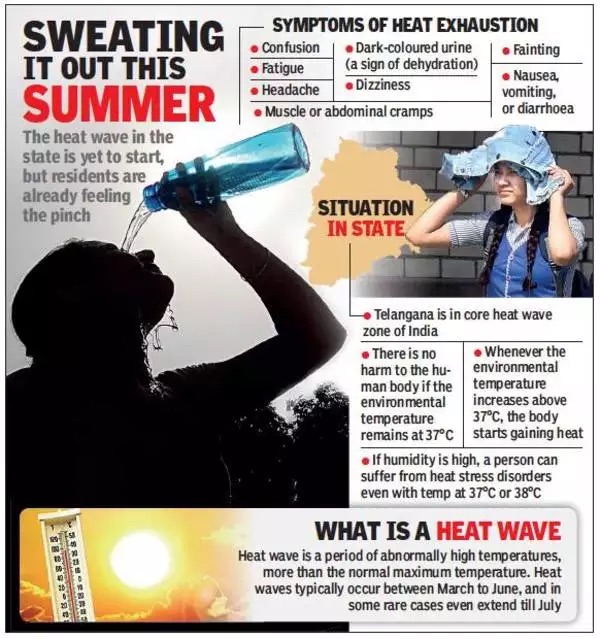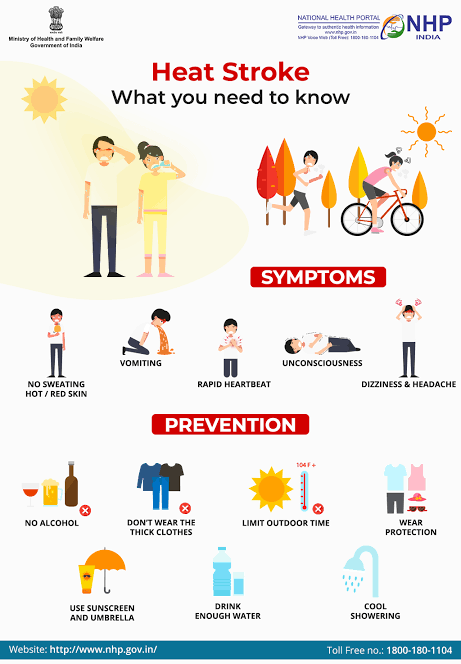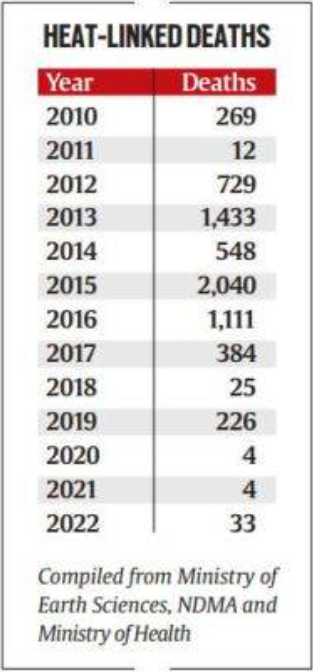ForumIAS announcing GS Foundation Program for UPSC CSE 2025-26 from 19 April. Click Here for more information.
Contents
| For 7PM Editorial Archives click HERE → |
Introduction
In India, heat strokes in India are becoming more frequent and intense due to climate change. Recently, thirteen people have died from an apparent heatstroke while attending a government award function in an open space in Navi Mumbai. This is possibly the biggest-ever heatwave-related death toll from a single event in the country.
Some areas like Gangetic West Bengal, coastal Andhra Pradesh, and Bihar are currently affected, and heat strokes are becoming a significant public health issue. These rising temperatures can impact public health, social and economic conditions, and even the overall development of India.
What are heat strokes?

Heat strokes, also known as sunstrokes, are severe heat-related illnesses that occur when the body overheats due to exposure to high temperatures and humidity or from continuous physical activity in those conditions. Heat stroke is considered a medical emergency and requires immediate treatment.
During a heat stroke, the body’s temperature-regulating mechanisms fail, causing the body temperature to rise rapidly. Symptoms of heatstroke include high body temperature, rapid heartbeat, confusion, nausea, vomiting, and seizures.
| Must read: Winter Heatwaves – Explained, pointwise |
How can heat strokes be fatal?

High temperature in itself is not fatal. The combination of high temperature and high humidity is referred to as the wet bulb temperature. This makes heat waves deadly.
High moisture content in the atmosphere makes it difficult for sweat to evaporate and bodies to cool down. This increases internal body temperature and is often fatal. When the body temperature reaches 104°F (40°C) or higher, it can lead to dehydration, organ damage, and even death if left untreated.
| Must read: Wet Bulb Temperature: Explained: India Heatwaves and the role humidity plays in making them deadly |
What are the reasons for increasing heat stroke events in India?

Reasons for Increasing Heat Strokes in India
Climate Change: Global warming and climate change contribute to rising temperatures in India, making heat waves more intense and frequent. For instance, in recent years, temperature records have been broken in various parts of India, leading to more cases of heat strokes as people are exposed to extreme heat.
El Nino effects: The end of the La Nina phase is expected to make this year’s summer very hot. El Nino, which has the opposite effect, may begin by May to July, increasing heat further. This could also potentially reduce rainfall during India’s monsoon season.
Urban Heat Island Effect: Concrete structures and lack of greenery in urban areas trap heat, raising the temperature in cities. For example, Delhi, a densely populated city with limited green spaces, experiences higher temperatures than its surrounding rural areas. This increases the risk of heat strokes for its residents.
Lack of Awareness and Preparedness: Many people are not aware of the risks associated with heat strokes or how to prevent them, leading to an increase in heat stroke cases. For instance, during the recent Mumbai event, almost a million people gathered on uncovered ground, leading to heat stress for over 120 people, resulting in 13 deaths and 18 hospitalizations.
Inadequate Infrastructure: Lack of access to cooling facilities like air conditioning or proper ventilation in buildings can exacerbate the risk of heat strokes.
| Read more: Do not let increasing heatwaves sap worker productivity in India |
What are the various initiatives undertaken to mitigate heat strokes?
Initiatives to Mitigate Heat Strokes
Heat Action Plans: Governments and local authorities implement heat action plan to raise awareness and prepare communities for heat waves. For example, Ahmedabad introduced a heat action plan that includes sending heatwave alerts, opening cooling centers, and training healthcare workers to deal with heat stroke cases.
Preparation of national guidelines for heat-wave management: In 2016, the National Disaster Management Authority (NDMA) issued comprehensive guidelines to prepare national-level key strategies for mitigating the impact of heatwaves.
Public Awareness Campaigns: Governments and NGOs run campaigns to educate people about the risks of heat strokes and how to prevent them. Example: A local NGO in Hyderabad conducted workshops in schools to teach children about the importance of staying hydrated, wearing appropriate clothing, and seeking shade during hot weather.
Urban Greening Initiatives: Planting trees and creating green spaces in urban areas help reduce the urban heat island effect and provide shade. For example, the city of Bengaluru initiated a project to plant one million trees across the city to increase green cover and reduce temperatures, thus decreasing the risk of heat strokes.
Access to Cooling Facilities: Governments and organizations work to provide access to cooling facilities, such as air conditioning or public cool spaces, for vulnerable populations.
Building Design and Policies: Incorporating heat-resilient building designs and enforcing policies to ensure adequate ventilation and insulation can help prevent heat strokes. The government introduced building codes requiring better insulation and ventilation in new constructions, reducing indoor temperatures and the risk of heat strokes.
| Read more: Without action plans, India’s poorest will continue to bear brunt of heatwaves: study |
What are the challenges in heat stroke mitigation?
Challenges in Heat Stroke Mitigation include,
Limited Awareness: Many people are not aware of the risks, prevention measures, and treatments associated with heat strokes, leading to insufficient preparedness. For example, in rural areas, lack of awareness may cause farmers to work during peak heat hours, increasing their risk of heat stroke.
Inadequate Infrastructure: Inadequate urban planning and infrastructure, like the lack of green spaces and poorly designed buildings, contribute to higher temperatures in cities. For instance, Slums in Mumbai often lack proper ventilation and shade, making residents more vulnerable to heat strokes.
Insufficient Healthcare Facilities: Limited healthcare facilities and trained professionals in rural and remote areas make it difficult to provide prompt treatment for heat stroke victims.
Climate Change: Increasing global temperatures and extreme weather events due to climate change are exacerbating the frequency and severity of heat waves, making heat stroke mitigation more challenging.
For example, unprecedented heatwaves in recent years have strained the capacity of communities and healthcare systems in India to effectively respond to heat stroke cases.
Climate-related injustice: Poverty, lack of access to resources, and limited education can hinder individuals’ ability to take preventive measures against heat strokes. Example: Low-income families in urban areas may not be able to afford proper cooling solutions or take time off work during peak heat hours, increasing their risk of heat strokes.
What should be done?
Actions to Combat Heat Strokes include
Need for Climate Literacy: Educate people on the risks, prevention measures, and treatments related to heat strokes through campaigns, workshops, and public service announcements. Example: Government agencies can run campaigns in local languages to reach a wider audience and improve awareness about heat stroke prevention.
Improve Infrastructure: Design urban spaces and buildings to be more resilient against heatwaves, by promoting green spaces and using heat-resistant construction materials. Such as encouraging the planting of trees in urban areas to create shaded spaces and reduce the overall temperature.
Enhance Healthcare Facilities: Ensure the availability of healthcare facilities, especially in rural and remote areas, and train medical professionals to handle heat stroke emergencies.
Such as, allocatung funds to establish health centers in vulnerable areas and provide training to local healthcare workers on managing heat stroke cases.
Implement Heat Action Plans: Develop and implement heat action plans at local and national levels to improve preparedness and response during heatwaves.
Address Climate Change: Take active steps to reduce greenhouse gas emissions and mitigate the effects of climate change that contribute to extreme heat events. For instance, implement policies that promote renewable energy sources, such as solar and wind power, to reduce the country’s carbon footprint and help combat climate change.
Support Vulnerable Communities: Focus on providing resources and assistance to socio-economically disadvantaged populations to help them take preventive measures against heat strokes. Such as establishing cooling centers in low-income neighborhoods or providing subsidies for energy-efficient cooling solutions to reduce the financial burden on vulnerable families.
Other initiatives: The Labour department on its part should sensitise and encourage employers to shift outdoor workers’ schedules away from peak afternoon hours during heat alert. Efforts should be made to ensure all amenities to children appearing for examinations in addition to prioritising maintenance of power to all critical facilities like hospitals and drinking water supply schemes.
| Must read: Marine heatwaves and its ecological impact |
Source: Indian Express (Article 1 and Article 2), The Hindu, The New Indian Express, Financial Express, NDTV and Livemint
Syllabus: GS 3: Disaster Management: Disaster and disaster management.




